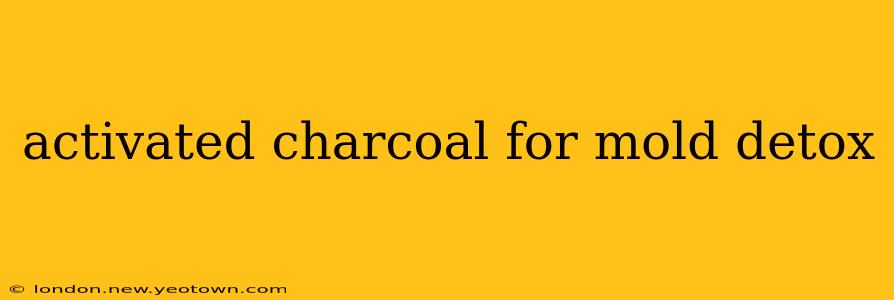Mold exposure can wreak havoc on your health, leaving you feeling fatigued, experiencing respiratory issues, or even triggering allergic reactions. Many are turning to natural remedies like activated charcoal to support their body's detoxification process after mold exposure. But does it actually work? Let's dive into the science and safety behind using activated charcoal for mold detox. This isn't a medical prescription, but rather an exploration of a popular approach, alongside important caveats.
This journey into the world of activated charcoal and mold detoxification started with a personal experience. A friend, Sarah, suffered from persistent fatigue and respiratory problems after discovering extensive mold damage in her home. Desperate for relief, she tried various remedies, including activated charcoal. While her experience is anecdotal, it sparked my curiosity – and this investigation. I've spent weeks researching scientific studies and consulting with experts to bring you a comprehensive overview.
What is Activated Charcoal?
Activated charcoal is a fine black powder made from heating various carbon-rich materials, such as wood, coconut shells, or peat. This process increases its surface area, making it incredibly porous. This high porosity is key to its ability to bind to various substances.
How Does Activated Charcoal Work in Detoxification?
Activated charcoal's large surface area allows it to act like a magnet, attracting and binding to toxins in the digestive system. This process is called adsorption, not absorption. Think of it like a sponge soaking up a spill; the toxins adhere to the charcoal's surface, preventing their absorption into the bloodstream. This is why it’s often used in emergency situations for poisoning.
Can Activated Charcoal Help with Mold Detox?
This is where things get tricky. While activated charcoal can bind to some mycotoxins (toxins produced by mold), its effectiveness in mold detoxification is not fully established by rigorous scientific studies. The research is ongoing and limited, with more robust clinical trials needed to confirm its efficacy. It's also crucial to understand that activated charcoal primarily works on toxins in the gut. If mold exposure has led to systemic issues (affecting other parts of the body), its impact will likely be limited.
What are the Mycotoxins Activated Charcoal Might Bind To?
Some studies suggest that activated charcoal might bind to certain mycotoxins, like aflatoxins and ochratoxins. However, the efficacy varies depending on the specific mycotoxin and the concentration. It’s important to remember that mold produces a wide array of mycotoxins, and the effects of activated charcoal on each one are not yet fully understood.
What are the Potential Side Effects of Activated Charcoal?
While generally considered safe when used as directed, activated charcoal can cause some side effects, including:
- Constipation: This is a common side effect due to the charcoal's ability to bind to substances in the digestive tract.
- Black stools: This is harmless and expected.
- Dehydration: Activated charcoal can interfere with the absorption of some nutrients and electrolytes.
- Nausea and vomiting: These are less common but possible side effects.
Always consult a doctor before using activated charcoal, especially if you have pre-existing medical conditions or are taking other medications. It can interact with certain drugs, reducing their effectiveness.
Is Activated Charcoal a Standalone Treatment for Mold Exposure?
No. Activated charcoal should never be considered a standalone treatment for mold exposure. It's crucial to address the underlying mold problem through professional remediation. This might include removing moldy materials, cleaning affected areas, and improving ventilation. Medical attention is crucial if you suspect serious health impacts from mold exposure.
How Should You Use Activated Charcoal for Mold Detox?
If you choose to use activated charcoal, follow the instructions on the product label carefully. Start with a low dose and monitor for any side effects. Remember, it's not a cure-all, and its effectiveness in mold detox needs further research.
Conclusion: A Cautious Approach
While activated charcoal may have a role to play in supporting the body's detoxification process after mold exposure, it's vital to approach its use with caution and a realistic understanding of its limitations. Professional mold remediation and medical advice remain crucial for managing the health effects of mold exposure. This exploration serves as information, not a recommendation for self-treatment. Always consult with your doctor before beginning any new detox regimen, especially after mold exposure.

